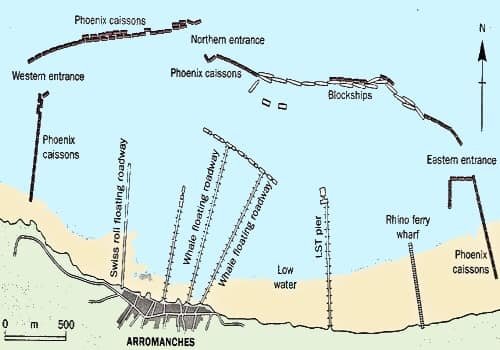Mulberry Artificial Harbors (#277)
Today’s post covers another aspect of the D-Day invasion -- the Mulberry Artificial Harbors.
This year, I am doing a series on leaders and leadership in the European Theater of Operations (ETO) in World War II. This is 22nd in the series. Check out the blog to see them all or go to the links at the bottom of this article to see the most recent ones.
Mulberry Artificial Harbors
Prior to D-Day, conventional wisdom believed that for an invasion to be successful, the invading force must capture a functioning port quickly so that they could supply their troops ashore and build up combat power for future operations.
As with many good ideas, the origin of the Mulberry Artificial Harbors are disputed. Prime Minister Winston Churchill claimed he was the inspiration, but others say that Commodore John Hughes-Hallet, from the staff of Combined Operations, stated that if they couldn’t capture a port, “we must take one with us.”
The Mulberry’s purpose was to create two artificial harbors to supply the Allied Expeditionary Force until a traditional ports could be captured and repaired. One Mulberry (Mulberry A) was scheduled to be constructed at Omaha Beach, while a second harbor (Mulberry B) would be established at Arromanches, near Gold Beach.
The basic components of the harbors were known as Corncobs, Phoenixes, Whales, and Beetles. Over 150 ships, known as Corncobs, were towed across the English channel and intentionally sunk to help act as breakwaters off the coast of all 5 beaches. 146 concrete caissons, known as Phoenixes, were towed across the Channel and sunk along an outer perimeter of the two Mulberries (Omaha and Gold Beaches) to act as an additional breakwater for the Mulberries. The Phoenixes weighed up to 6,000 tons and were 200 feet in length. Finally, Whales were dock piers. These piers were the floating roadways that connected the pier heads to the land. Designed by Allan Beckett, the innovative roadways were flexible 80 feet long bridging units mounted on pontoons. The piers could rise and fall with the tide due to their flexibility. Finally, the Beetles were floating pontoons that were anchored to the sea floor and supported the Whales. In the picture above it is easy to see the Whales and Beetles that make up the piers.
Detailed Map of the Gold Beach Mulberry
Mulberry A outside Omaha Beach was fully operational on June 18, but the following day it was wrecked by a storm, which also caused considerable damage to Mulberry B at Arromanches/Gold Beach. The latter was repaired and was used for 10 months after D-Day. Over the course of its operation, over 2.5 million men, 500,000 vehicles, and 4 million tons of supplies were able to land in France.
The remains of Mulberry B are still visible today near the beaches at Arromanches.
Application
The Mulberry Harbor enabled the Allies to consider the placement of the Overlord invasion almost anywhere on the French coastline, rather than at the ports of Cherbourg or Pas de Calais. This preserved an element of tactical surprise for the Allies. Where is your organization thinking outside the box or against conventional wisdom to gain a competitive advantage?
Sometimes the easiest way to get your team to think creatively is to get the group to spend time collaborating on the question of “what problem are we really trying to solve?” For the Allies, the difference between “What port should we seize for the Overlord invasion?” versus “Where could we land the Overlord invasion and establish Mulberry ports?” as a problem statement led to the creative solution of landing in Normandy.
Conclusion
The last five blog posts on leaders and leadership from the World War II European Theater of Operations are:
Interested in bringing your team to Leadership Experience that uses historic case studies, like the Mulberry Harbors during D-Day to enhance your team’s leadership today? How is your team innovating and coming up with creative solutions? TFCG offers the D-Day, Market-Garden, and Battle of the Bulge Leadership Experiences in Europe. TFCG also offers the Eisenhower, Currahee!, the War in the Pacific Museum, and Pearl Harbor Leadership Experiences in the United States. Send me an email and we can start the discussion today about building better leaders in your organization using a historic Leadership Experience. Or click on one of the pictures to learn more about that specific program.
In the meantime, go on the offensive and use the story of the Mulberry Harbors to inspire you this week.

